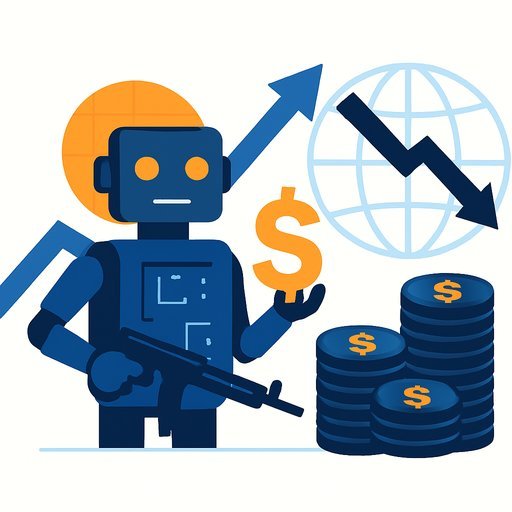KPMG 2025 Global CEO Outlook: What Executives Need to Do Now
Leaders are cautious about the macro picture, yet confident in their own plans. While confidence in the global economy has dropped to five-year lows (68 percent), 79 percent of CEOs are optimistic about their organization's prospects. The play is clear: double down on AI and talent to build resilience and drive growth.
Most CEOs (72 percent) have already adjusted their growth strategies. Over the next three years, the majority expect higher revenues and larger workforces - backed by targeted investment in AI, skills, M&A, and organizational design.
Key numbers at a glance
- AI as a top investment priority: 71 percent; ROI expected in 1-3 years by 67 percent
- Budget shift: 69 percent allocating 10-20 percent to AI
- Headcount: 92 percent plan to increase
- M&A impact: 89 percent expect moderate to significant activity
- Leadership focus: agility (26 percent), transparent communication (24 percent), risk prioritization (23 percent)
Economic Outlook: Confidence in the Plan, Not the Noise
Despite geopolitics and uncertainty, CEOs are backing their strategy. Sixty-one percent forecast earnings growth of 2.5 percent or more over the next three years. Resilience is being built through people, AI, and deals - not defensive cost-cutting.
Top pressures shaping investment decisions are clear and concrete:
- Cybersecurity and digital risk resilience: 39 percent
- Regulatory compliance and reporting: 36 percent
- AI integration into operations and workflow: 34 percent
The CEO role is getting heavier. Fifty-nine percent say expectations and complexity have increased in five years, and 23 percent call out AI and digital literacy as essential skills. Eighty percent feel more pressure to secure long-term prosperity - and are acting accordingly.
Technology and AI: From Experiments to Enterprise Value
AI is now a top-three budget line. Seventy-one percent of CEOs prioritize it, and two-thirds expect returns in one to three years - a faster horizon than last year. Confidence is rising: 74 percent believe they can keep pace with AI's development, and 89 percent say their boards are ready to govern advanced tech adoption.
How leaders are building momentum:
- Encouraging hands-on experimentation across levels: 84 percent
- Open dialogue about role impact: 46 percent communicating directly with employees
- Planning for agentic AI: 57 percent expect significant impact alongside generative AI
Risk posture is maturing, but friction points remain. While 76 percent say they have governance in place, the biggest issues cited are ethics (59 percent), data readiness (52 percent), and the lack - and pace - of regulation (50 percent; 69 percent see the speed of regulation as a barrier).
Useful references on principles and policy are emerging: see the OECD AI Principles and the EU's AI Act overview.
Talent: Compete on Skills, Culture, and Speed
AI value is a people issue first. Seventy-seven percent of CEOs believe workforce AI readiness and upskilling will define prosperity over the next three years. The constraint is talent supply: 70 percent say competition for AI skills could limit success.
Boards are moving fast:
- Retain and retrain high-potential talent: 71 percent
- Hire AI and tech skills: 61 percent
- Address culture risk: 63 percent worry about AI's impact on culture; 33 percent see resistance to new tech
Demographics add another layer. Eighty-eight percent expect a moderate to high impact from labor market shifts and an aging workforce. Key gaps: future skills by generation (30 percent) and retirements outpacing replacements (24 percent). Managing the multi-generational workplace is now a strategic item, not an HR footnote.
If you're scaling capability, curated programs can speed progress. Explore role-based options here: AI courses by job or scan new releases: Latest AI courses.
ESG: Rising Confidence, Clearer Constraints
Commitment to sustainability remains firm and more grounded. Sixty-one percent say they're on track for 2030 net zero targets (up from 51 percent). The biggest blockers are practical: supply chain decarbonization complexity (25 percent) and limited skills to implement solutions (21 percent). Cost is a lower concern (11 percent).
AI is becoming a force multiplier for ESG execution. Top use cases include:
- Better sustainability data and reporting: 79 percent
- Resource efficiency opportunities: 79 percent
- Emissions reduction and energy efficiency: 78 percent
Reporting is a priority: 51 percent are leaning into evolving standards to meet investor and regulatory demands. Sixty-five percent say sustainability is fully embedded and critical to long-term success - yet only 29 percent have comprehensively integrated it into capital expenditure decisions. That's the next gap to close.
What to Do Next: A Practical 90-Day Plan
- Refocus strategy: Tie AI initiatives to 2-3 revenue or cost outcomes with 12-18 month line-of-sight. Kill pilots without a path to scale.
- Data first: Stand up a cross-functional data readiness sprint to improve quality, lineage, and access for top AI use cases.
- Governance that moves: Establish a lightweight AI risk and model governance process that can adapt as use cases expand.
- People plan: Launch an AI skills baseline, set role-based learning paths, and fund manager-led experimentation time.
- Operating model: Redesign 2-3 workflows where AI agents can own tasks end-to-end, with clear human oversight.
- Cyber and compliance: Run a controls gap check across AI-enabled workflows; align with board reporting on risk and ROI.
- ESG execution: Prioritize supply chain decarbonization pilots with measurable abatement and vendor enablement.
- M&A lens: Build a capability map for AI and data - use it to source targets and partnerships that compress time-to-value.
Methodology
Findings are based on the KPMG 2025 CEO Outlook, a survey of 1,350 CEOs conducted between 5 August and 10 September 2025. Respondents lead companies with revenues over US$500M across 11 markets and 12 sectors. Some figures may not total 100 percent due to rounding.
Your membership also unlocks:






